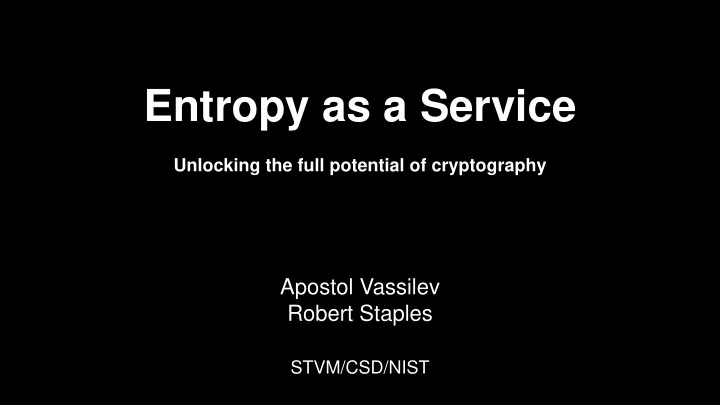

Entropy as a Service Unlocking the full potential of cryptography Apostol Vassilev Robert Staples STVM/CSD/NIST
A perspective: cryptography evolves very fast to provide security in cyberspace Emerging crypto technologies - lightweight crypto - lighter versions of legacy protocols - tinyDTLS, lightweight DTLS - post-quantum cryptography New crypto is cool but have we solved all known problems with conventional crypto?
• In modern cryptography the algorithms are well-known • Security depends largely on the secrecy of the keys • Cryptographic keys must be (nearly) impossible to guess • Key generation and key management govern the strength and security of keys • Key generation is strongly dependent on entropy Courtesy of XKCD
The big question Where are the keys coming from?
Real World Examples 2013 • Factoring RSA keys from certified smart cards (Coppersmith in the wild) , • Bernstein, Chang, Cheng, Chou, Heninger, Lange, van Someren Problem: Low-quality hardware RNG, stuck in a short cycle: • 0 0 1 0 0 1 0 0 1 0 0 1 0 0 1 0 0 1 0 0 1 0 0 1 0 0 1 0 0 1 0 0 1 0 0 1 0 0 1 0 0 1 0 0 1 0 0 1 0 0 1 0 0 1 0 0 1 0 0 1 0 0 1 0 0 1 0 0 1 0 0 1 0 0 1 0 0 1 0 0 1 0 0 1 0 0 1 0 0 1 0 0 1 0 0 1 0 0 1 0 0 1 0 0 1 0 0 1 0 0 1 0 0 1 0 0 1 0 0 1 0 0 1 0 0 1 0 0 1 0 0 1 0 0 1 0 0 1 0 0 1 0 0 1 etc. Likely reasons for using this weak design : cost of high-quality hardware, the cost of licensing patents 5
Real World Examples 2012 • Mining Your Ps and Qs: Detection of Widespread Weak Keys in Network Devices (Heninger, Durumeric, Wustrow, Halderman) Scanned 28 Mil TLS and 23 Mil SSH hosts on the Internet • - 0.75% of TLS certificates share keys - due to insufficient entropy during key generation - another 1.70% come from same faulty implementations • - able to obtain RSA private keys for 0.50% of TLS hosts and 0.03% of SSH hosts • - public keys shared nontrivial common factors due to entropy problems • - able to obtain DSA private keys for 1.03% of SSH hosts - due to insufficient signature randomness 6
Real World Examples 2016 • The Linux kernel dissected - four sources of kernel entropy: • • Device • • Input • • Interrupt • • Disk Strong demand for entropy through /dev/urandom (non-blocking) • “minimal” (no GUI) • Ubuntu Server • v14.04.3 64-bit w/ • Kernel v4.2.3 7
Testing randomness is hard • Using a finite set of statistical tests on data samples can lead to misleading results – EXAMPLE: expand a well-known irrational number, e.g. π , and test the output bit sequence for randomness. Chances are, it will be reported as random. Using the statistical test approach makes it hard to automate the estimation of entropy – automation is critically important for the new CMVP NIST 8
Our approach High-Quality entropy from a provably good source • How about delivering high-entropy random data from a provably good source to needy clients? • Public service providing high-entropy random data for use in cryptography - Entropy as a Service (EaaS) – - delivers entropy securely (no one can see) upon request from clients – - clients seed DRBG’s after mixing EaaS random data with local random data – - clients use the DRBG output to generate local keys independently from EaaS 9
Our solution is • NOT a key generation service – - cryptographic keys are generated locally on the client using DRBG’s – - clients DRBG’s are seeded with random data resulting from mixing several independent sources, including local random data – - even if an attacker gains full control of one server, he/she will have no possibility of gaining meaningful insights into the clients’ keys • NOT similar to the NIST beacon – - EaaS does NOT record any incoming or outgoing record – - EaaS does NOT record any internally generated random data 10
Our solution is 11
A protocol sketch Client EaaS HTTP GET (w/ own public key and the number of requested random bytes) • • <response> • <entropy> • encrypted base64-encoded random blob • </entropy> • <timestamp></timestamp> • <dsig></dsig> • </response> 12
Potential attacks and defenses • Attacks mitigated by protocol features and provisioning – - Message replay – - Man-In-The-Middle – - DNS poisoning 13
Potential attacks and defenses • Attacks mitigated by mixing data from multiple EaaS instances – - Honest-but-curious EaaS instance – - Dishonest but non-colluding EaaS instances – - Dishonest and colluding EaaS instances 14
Status and next steps Linux Kernel Entropy Revisited: • uses EaaS client to request random bits from EaaS server and seeds the image pool • C program, using the “RNDADDENTROPY” ioctl to add the entropy. 15
Status and next steps • See project page at : http://csrc.nist.gov/projects/eaas/ – Functional prototype implemented • - demonstrated in September at the CIF 2015 in Washington, DC – Planning to stand-up a publicly accessible NIST EaaS in Q2, 2016 • - publish server and client sample code on GitHub – - allow people to look, enhance, adopt as they please – Conceive a public criteria for reputable EaaS hosts 16
Questions?
Recommend
More recommend